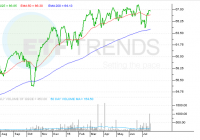Apple Teaches Another Lesson In ETF Weighting
Summary Apple’s stock price fell in response to disappointing numbers. Due to its large market capitalization, the company’s moves will affect sector ETFs, notably those that track the tech industry. Alternatively, investors can use ETFs that track equal-weight methodologies to diminish the effect AAPL has on a tech sector investment. By Todd Shriber & Tom Lydon Shares of Apple (NASDAQ: AAPL ) fell 4.3% Wednesday, and at one point during the session, the iPhone maker was lighter by $60 billion in market value, after the company “disappointed” Wall Street by reporting that fiscal third-quarter profit rose “slightly” to $10.7 billion from $7.74 billion on revenue of “just” $49.61 billion. Apple’s Wednesday woes are, predictably, having a dour effect on the exchange traded funds that feature heavy allocations to the iPad maker. For example, the Technology Select Sector SPDR ETF (NYSEARCA: XLK ), the largest technology ETF by assets, has an almost 18% weight to Apple, enough to have the fund trading lower by 1.5% today. XLK’s Wednesday decline, and those of rival technology ETFs with significant Apple weights, reminds investors of the potential dangers of owning a fund with large weights to just one or two stocks. “Apple is a top-10 holding in 98 equity ETFs according to S&P Capital IQ. Besides being the largest stock, ETFs tied to the S&P 500 index like Vanguard S&P 500 ETF (NYSEARCA: VOO ) and the Russell 1000 like the iShares Russell 1000 ETF (NYSEARCA: IWB ), the technology giant is more heavily weighted in popular tech-laden products,” according to S&P Capital IQ. The PowerShares QQQ Trust ETF (NASDAQ: QQQ ), the NASDAQ-100 (NDQ) tracking ETF, entered Wednesday with a roughly 14% weight to Apple, enough to send that ETF lower by more than 1%. The $2.9 billion iShares U.S. Technology ETF (NYSEARCA: IYW ) is perhaps the epitome of an “Apple ETF” with a 20.9% weight (as of July 21) to the stock. That big Apple weight was enough to drag IYW lower by almost 2% yesterday. As S&P Capital IQ notes, there are ways to maintain tech sector exposure via ETFs while mitigating Apple or any other single stock risk. The First Trust NASDAQ-100 Equal Weight Index ETF (NASDAQ: QQEW ) and the Direxion NASDAQ-100 Equal Weighted Index Shares ETF (NYSEARCA: QQQE ) are equal-weight alternatives to QQQ. No stock accounts for more than 1.2% of QQEW’s weight and QQQE had 1% weight to its constituents at the end of the second quarter, according to issuer data . Those ETFs lost about a third of a percent yesterday. The rub is that when Apple performs well, QQQE and QQEW will lag QQQ. Even with Wednesday’s slide, Apple is up more than 13% this year, helping QQQ to a 9% gain, better than double the returns of QQQE and QQEW. The $954.2 million Guggenheim S&P Equal Weight Technology ETF (NYSEARCA: RYT ) has a weight of less than 1.6% to Apple. That is less than the ETF’s weight to Facebook (NASDAQ: FB ), eBay (NASDAQ: EBAY ) and Visa (NYSE: V ). S&P Capital IQ has market weight ratings on QTEW and RYT. Direxion NASDAQ-100 Equal Weighted Index Shares ETF (click to enlarge) Tom Lydon’s clients own shares of Apple, Facebook and QQQ. Disclosure: I am/we are long QQQ, AAPL, FB. (More…) I wrote this article myself, and it expresses my own opinions. I am not receiving compensation for it. I have no business relationship with any company whose stock is mentioned in this article.
